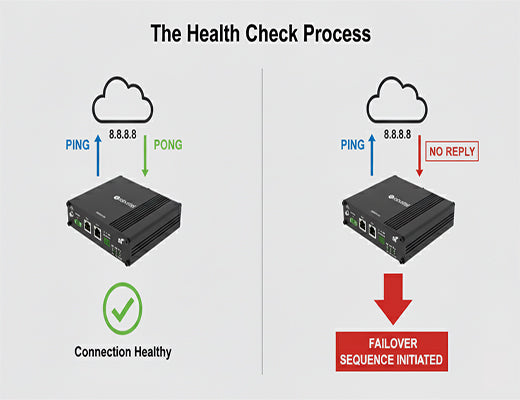
How Dual SIM Failover Works: A Deep Dive into Uninterrupted Connectivity
|
|
Time to read 5 min
|
|
Time to read 5 min
This technical deep dive explains exactly how dual SIM failover works in an industrial router. We'll go beyond the basics to explore the intelligent health checks (like ping detection and signal strength monitoring) that trigger the switch, the process of failing over to a secondary carrier, and the critical importance of automatic failback for a truly resilient and cost-effective network redundancy strategy.
Dual SIM failover relies on intelligent "health checks" to constantly monitor the primary cellular connection's performance.
The failover trigger is not just a lost connection; it can be configured based on high latency, low signal strength, or ping failures.
Carrier diversity—using SIM cards from two different network operators—is essential for true redundancy.
Automatic failback to the primary SIM once it's restored is a crucial feature for controlling data costs and maintaining optimal performance.
Most people understand the basic concept of dual SIM failover: if one network connection dies, the router switches to another. Simple enough, right? But I've learned from countless technical support calls that the real questions, the ones that separate a professional solution from a basic one, are in the details.
How exactly does the router know the connection has failed? Is it instant? What happens when the first network comes back online?
Let's be clear: the difference between a frustratingly unreliable failover system and a truly "unbreakable" one lies in the intelligence of its execution. So, let's pop the hood and take a deep dive into how dual SIM failover works at a technical level.

This is the most common and reliable health check.
The best systems go even further, allowing for proactive switching based on poor performance, not just total failure.
Once the health checks have declared the primary link down, a precise sequence of events happens inside the router's operating system (like RobustOS).
wwan0). This terminates the existing connection.wwan1).This entire process is typically completed in under 30 seconds, ensuring minimal disruption to the end devices.
A system isn't truly automated if it requires a human to switch it back. This is why automatic failback is a non-negotiable feature.
Once the failover has occurred, the router doesn't forget about the primary SIM. It continues to run health checks on that inactive link in the background.
This is absolutely essential for controlling data costs (as backup plans may be more expensive) and ensuring your system is always using its optimal connection path.

Now you know how dual SIM failover works. It’s not just about having two SIM slots; it's about the intelligence of the underlying software that constantly monitors, reliably switches, and smartly switches back. This sophisticated process, happening invisibly inside a rugged industrial router, is what turns a simple cellular connection into a resilient, unbreakable lifeline for your mission-critical assets.
Learn More in our main guide:

A1: Carrier diversity is the practice of using SIM cards from two completely different network operators (e.g., AT&T and Verizon in the US). This is critically important because it protects you from a failure of a single carrier's entire network. If both your SIMs were from the same carrier, a network-wide outage would take both your primary and backup connections offline.
A2: Yes. A professional industrial router will keep a detailed internal log of all failover and failback events. Furthermore, if the router is connected to a cloud management platform like RCMS, it can be configured to send you an immediate email or platform alert the moment a failover occurs.
A3: No, a well-designed system prevents "flapping" (switching back and forth too frequently). It uses configurable timers and retry counts. For example, it might need to see a ping failure for 30 consecutive seconds before it triggers a failover, and it might need to see the primary link be stable for 5 continuous minutes before it fails back.